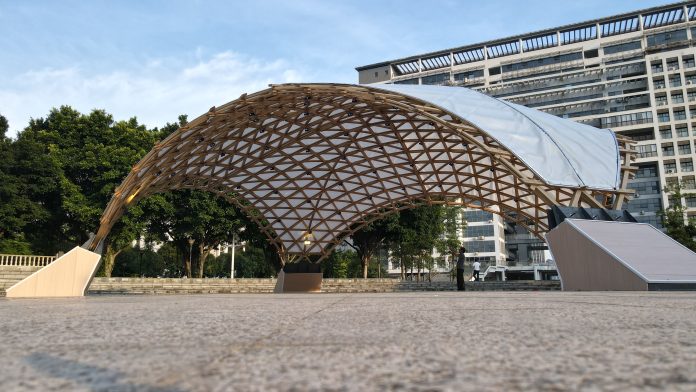Researchers at Edinburgh Napier University showcased their innovative research in bio-based construction by leading an engineered bamboo-timber composite gridshell construction project, completed by students from three universities
Sustainable construction practices prioritise minimising environmental impact, conserving resources and promoting long-term ecological balance. Timber and engineered bamboo are two renewable and eco-friendly materials that have a significant role to play.
Architects, engineers and contractors are increasingly embracing bio-based materials in construction, including timber and engineered bamboo, in order to achieve sustainable and environmentally friendly building solutions.
In this pursuit, academics and researchers offer a valuable contribution to their dedicated study and exploration of greener materials, technologies and methodologies.
Engineered bamboo, produced through processes like laminating or compressing bamboo fibres, enhances its durability, strength and dimensional stability.
It has an impressive strength-to-weight ratio, similar to carbon steel but with weaker interlay shear strength. This has prevented its full capacity from being used in a building design.
To overcome this problem, researchers from Edinburgh Napier University have developed an innovative engineered bamboo and timber composite material and structural systems.
By optimising the composite layout of engineered bamboo and softwood timber, according to their mechanical properties and effects of loading, the composite maximises the exploitation of both materials.
The result can be used to build taller buildings and roof structures with a longer span. While continuing to develop different structural systems with this material, the project team lead is also actively searching and developing the application scenarios to demonstrate the potential of this innovative, green and beautiful material.
Bamboo-timber composite gridshell prototype showcased in COP26 Glasgow 2021
Gridshells are curved, shell-like structures composed of interconnected straight or curved members forming a grid pattern. They are known for their structural efficiency and aesthetic appeal.
The grishell can be assembled from multiple panels, and be disassembled and reused. By using bamboo and timber as the primary construction materials, the gridshell becomes environmentally friendly and renewable.
Working with International Bamboo & Rattan Organisation (INBAR) and Built Environment – Smarter Transformation (BE-ST), the Edinburgh Napier project team has constructed a 2.4m x 2.4m gridshell prototype structure and showcased their pioneering research on bamboo-timber composite structures at the COP26 conference in Glasgow two years ago.
Real-scale construction of world’s first bamboo-timber composite gridshell
The overwhelmingly positive feedback from industry, academic peers and the public at COP26 gave the project team the confidence to scale it up.
Joined by the construction management team from Guangxi University of Science & Technology and the architecture team from the Inner Mongolia University of Science & Technology, the trilateral project team secured British Council and the Turing Scheme UK funding in 2022 to support the academics and students’ participation from three institutions.
This paved the way for construction to start in early June in Guangxi, China. The structure was assembled by the student groups from three universities, supervised by the academics. The finished 12m x 12m gridshell is formed by five layers of laminated bamboo and timber laths.
The bottom two layers are softwood timber laths, followed by two layers of laminated bamboo laths. After the gridshell formed the shape, the fifth layer of diagonal laths was installed on the top to hold it.
The construction was completed as planned, with an opening ceremony hosted on 28 June. The finished product will now be demonstrated in the university campus in Guangxi for three months, before being disassembled and re-erected in a Bamboo & Wood Industrial Park in Liuzhou city in Guangxi.
The future of bio-based construction
This project showcased the pioneering research in bio-based construction at Edinburgh Napier University, while serving as a testament to the immense potential of innovative sustainable construction technology in shaping a better future for the greener built environment we are creating.
Bamboo and timber are two wonderful construction materials gifted by nature. Our research aim is to combine fast-growing bamboo and softwood timber together to create high-strength, lightweight, economical and sustainable construction materials to replace not only unsustainable concrete and steel but also other less sustainable, heavy, expensive, slow-growing natural materials such as hardwood.
Professor Johnson Zhang
Head of international for the School of Engineering & the Built Environment
Edinburgh Napier University
Tel: +44 (0)333 900 6040














